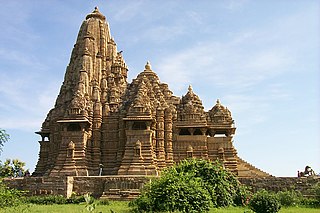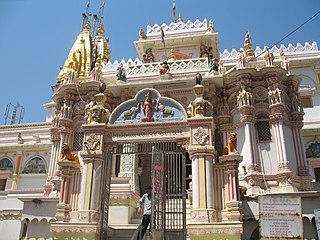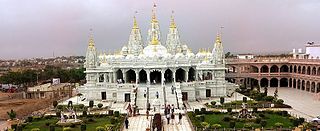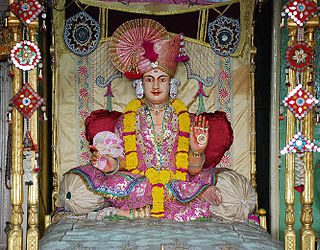
The Laxminarayan Dev Gadi is one of the two gadis (thrones) that together form the Swaminarayan Sampraday. It is headquartered at the Shri Swaminarayan Mandir, Vadtal and controls the Dakshin Vibhag Lekh.

Shri Swaminarayan Mandir, Mumbai(Marathi: श्री स्वामीनारायण मंदिर, मुंबई) is a Hindu temple (Mandir) and a part of the Swaminarayan Sampraday. This Swaminarayan Temple is located in the Bhuleshwar area of Mumbai and is the oldest Swaminarayan Mandir in Mumbai, being over a hundred years old.
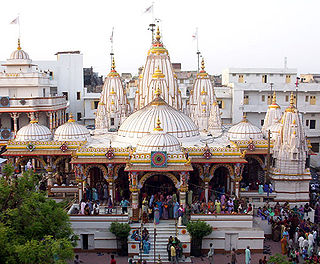
Shree Swaminarayan Mandir Kalupur is the first temple of the Swaminarayan Sampraday, a Hindu sect. It is located in Kalupur area of Ahmedabad, the largest city in Gujarat, India. It was built on the instructions of Swaminarayan Bhagwan, the founder of the sect.

Shri Swaminarayan Mandir, Vadtal headquarters of the Shri LaxmiNarayan Dev Gadi are located in this temple in Vadtal. There are three main shrines in the temple the central shirne of this temple is that of Lakshmi Narayan and RanchodRaiji. On the right there is an image of Radha Krishna with Swaminarayan in the form of Hari Krishna and the left has Vasudev, Dharma and Bhakti. The wooden pillars of the temple bear colourful wood carvings. There is a dharamsala within the temple premises. Gnyanbaug is a garden to the northwest of the temple gate that has four memorials dedicated to Swaminarayan. vadtal swaminarayan temple now declared as a pilgrim center by government of Gujarat and to be part of shrines recognized by Gujarat's Pavitra Yatradham Vikas Board, announced by Gujarat's Chief Minister Vijay Rupaniji.

Shri Swaminarayan Mandir, Dholera is a Hindu temple in Dholera, India, and is one of six Shri Swaminarayan Temples built by Swaminarayan.
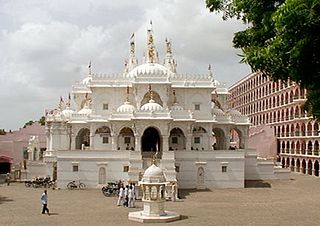
Shri Swaminarayan Mandir, Gadhada also known as Gopinathji mandir is a Hindu temple in Gadhada. This temple was built by Lord Swaminarayan himself.

Tejendraprasad Pande, formally known by his full title as Sanatan Dharma Dhurandar Acharya Maharaj Shree 1008 Tejendraprasadji Maharaj was appointed acharya of the Narnarayan Dev gadi (Ahmedabad) of the Swaminarayan Sampraday, a Hindu sect, by his father, the previous acharya, Devendraprasad, and was enthroned on 13 October 1969.

Acharya Shree Tejendraprasadji Maharaj founded International Swaminarayan Satsang Organization (I.S.S.O.) in the United States on the occasion of Vijaya Dashami in the year 1978.

NarNarayan Dev Yuvak Mandal (NNDYM) was founded by Koshalendraprasad Pande in 1994 with its headquarters at the Kalupur Swaminarayan Mandir (Ahmedabad) and was created to help young people to confront the challenges of life.
The Desh Vibhag Lekh is the last and final lekh (testament) of Sahajanand Swami or Swaminarayan.

The Naranarāyan Dēv Gadī, named after NarNarayan Dev, is one of the two Gadis (seats) that together form the Swaminarayan Sampraday. Its headquarter is at the Shri Swaminarayan Mandir, Ahmedabad and controls the Uttar Vibhag.
A follower of Swaminarayan is referred to as a Satsangi. There are eight important things in the life of a Satsangi.
Lord Swaminarayan is the founder of the Swaminarayan Sampraday previously known as under his guru, Sadguru Shree Ramanand Swami, as the Uddhav Sampraday.
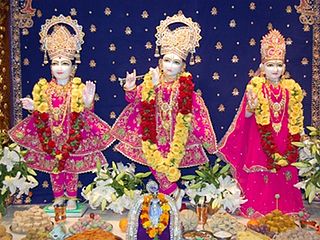
The Swaminarayan Mandir in Auckland is the first Mandir (Temple) of the Swaminarayan Sampraday in New Zealand. The Mandir comes under the ISSO of the NarNarayan Dev Gadi.

The Swaminarayan Mandir in Weehawken, New Jersey is the first Swaminarayan temple in the United States. It is the national headquarters of the ISSO and comes under the NarNarayan Dev Gadi of the Swaminarayan Sampraday. Today there are four Swaminarayan temples in New Jersey alone.

Shree Kutch Satsang Swaminarayan Temple (Bolton) is a three storied Swaminarayan Temple on Adelaide Street in Bolton, Greater Manchester, England. It is the first Swaminarayan temple to be established in the UK and Europe, officially opening in 1973. On 6 September 1973 a constitution was registered for the Temple under the Place of Worship Act, and on 6 September 1975 specially prepared murtis from the head Temple in Bhuj were installed in the Temple. The original structure was demolished and rebuilt in 1993. Prior to the new building a labour club and terraced houses were present on the temple site.

Koshalendraprasad Pande is the current Acharya of the NarNarayan Dev Gadi of the Swaminarayan Sampraday and is the 7th successor of Swaminarayan in the North Diocese.

